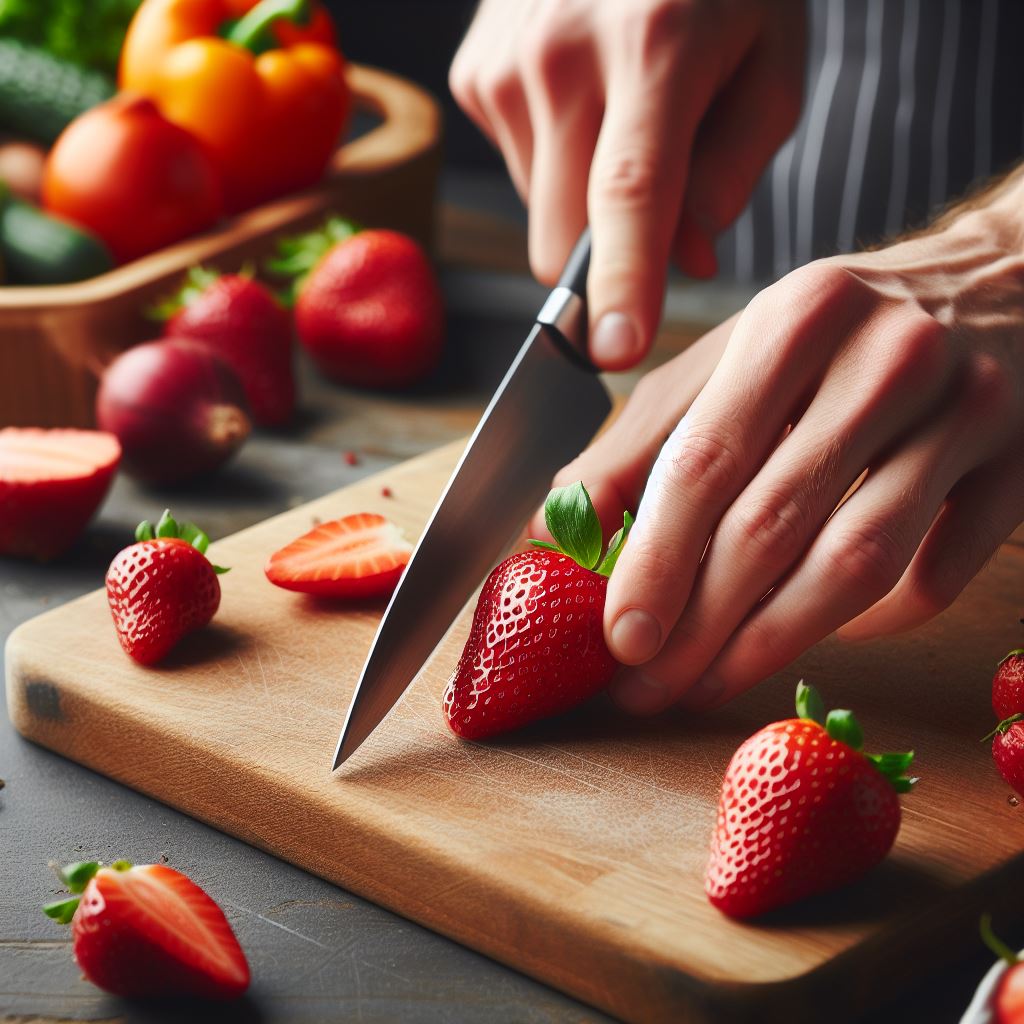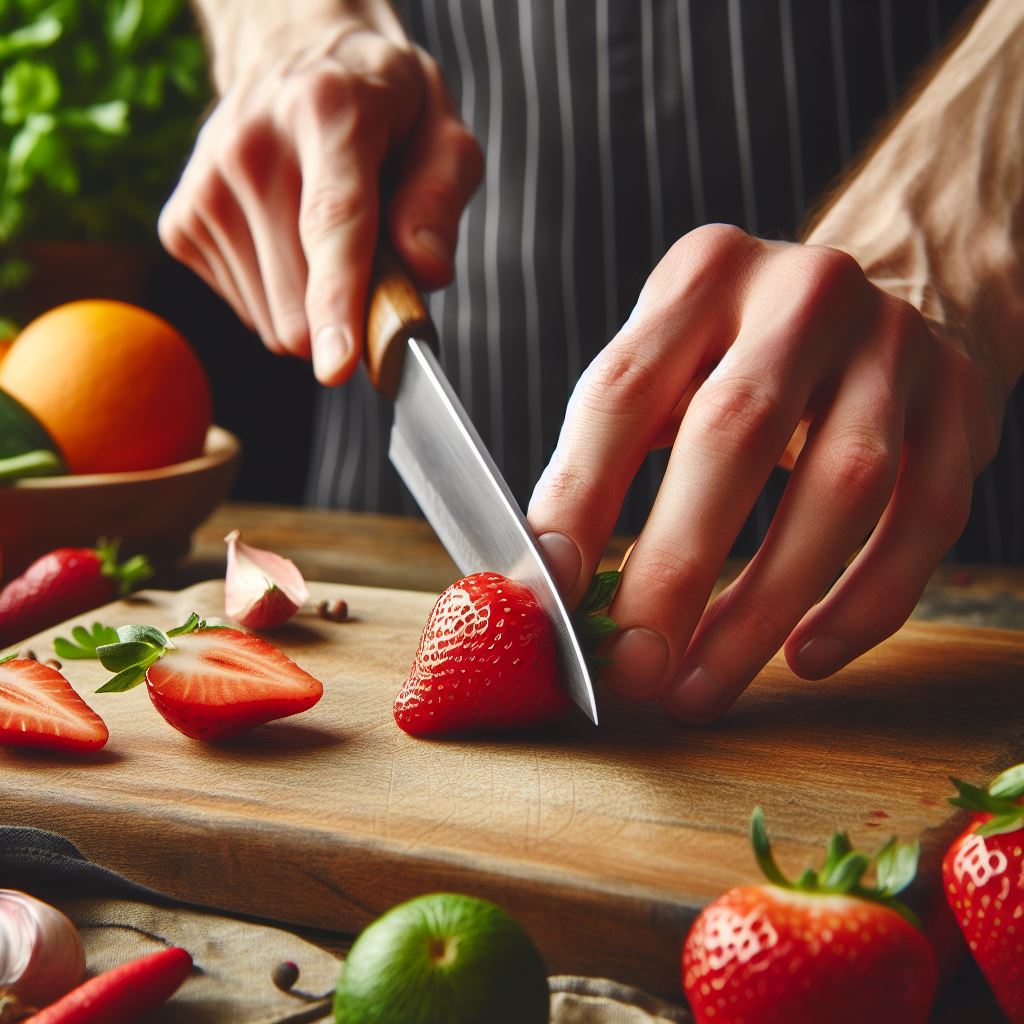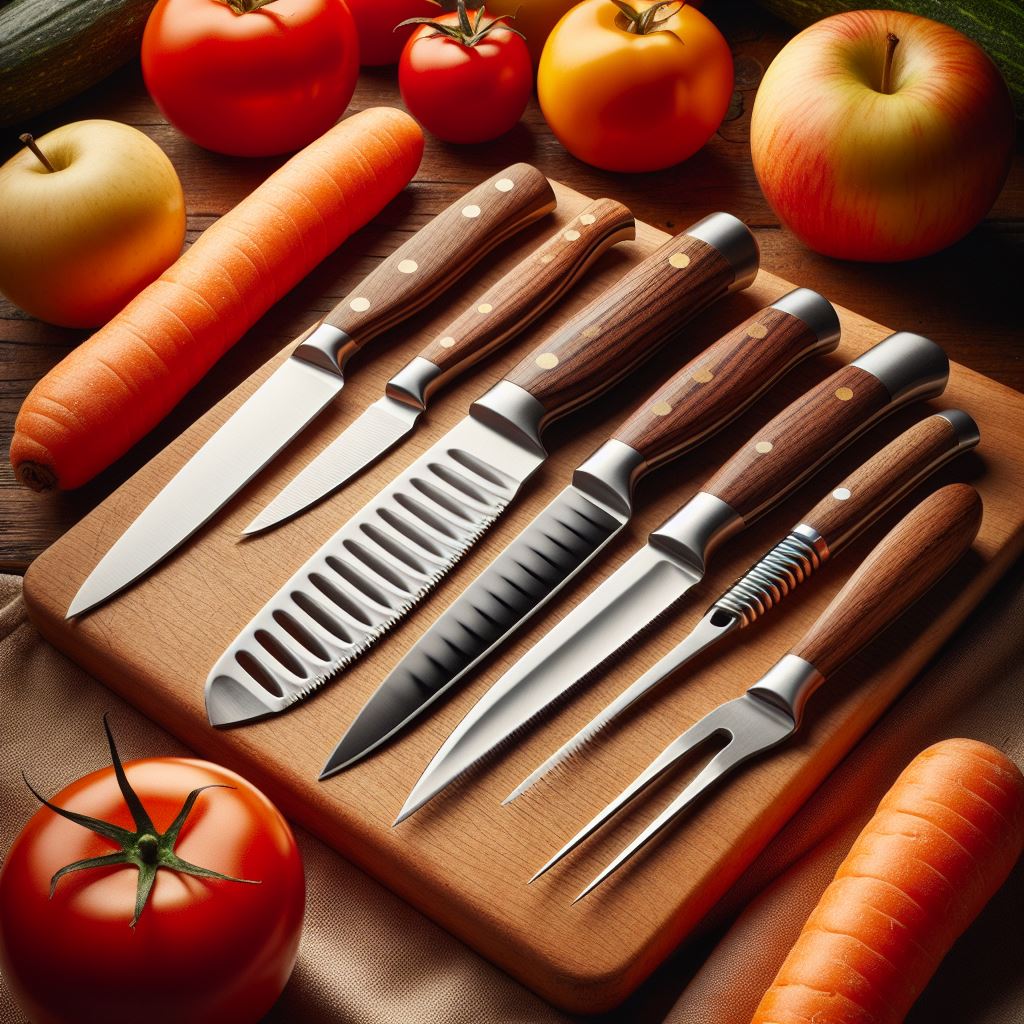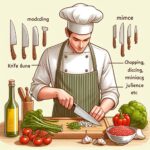A paring knife is used for peeling, slicing, and other fine cutting tasks. It excels in precision work with small fruits and vegetables.
In the culinary world, a paring knife stands as an essential tool for detailed kitchen tasks. Its sharp, small blade makes it the perfect companion for tackling intricate cuts that larger knives can’t handle with the same dexterity. Professional chefs and home cooks alike rely on the paring knife for its versatility and ease of control.
Its size allows for close-up work, giving you the ability to peel an apple, devein a shrimp, or artfully cut garnishes. Investing in a quality paring knife means ensuring your kitchen is equipped for precision work, while also maintaining efficiency and productivity in preparing a wide array of ingredients. With this must-have kitchen gadget, you’re well on your way to elevating your culinary skills to the next level.

Introduction To Paring Knives
Embark on a culinary journey as you unveil the secrets of one of the most underrated yet indispensable tools in the kitchen – the paring knife. A sleeved virtuoso in peeling, slicing, and intricacies beyond its size, understanding what a paring knife is and how to wield it will transform your kitchen exploits.
Defining The Paring Knife
A paring knife is a small, versatile kitchen utensil known for its pointed tip and plain edge. Precisely designed for finesse, it offers unmatched control for tasks where larger knives might prove unwieldy. Often ranging from 2.5 to 4 inches in blade length, this culinary partner excels in tasks requiring precision, such as deveining shrimp, removing seeds, or intricately cutting designs into fruit and vegetables.
A Brief History Of The Paring Knife
The genesis of the paring knife dates back to the 19th century, born out of the need for a specialized instrument for intricate kitchen tasks. Originally used by European farmers for a myriad of tasks beyond cooking, its functionality has been honed over the years. Today, it stands as an essential component of both professional chefs’ and home cooks’ arsenals alike.
Comparison With Other Kitchen Knives
| Knife Type | Blade Length | Intended Use |
|---|---|---|
| Paring Knife | 2.5 to 4 inches | Precise cuts, peeling, trimming |
| Chef’s Knife | 8 to 10 inches | General purpose, chopping, slicing |
| Bread Knife | 7 to 10 inches | Serrated for slicing bread |
| Utility Knife | 4 to 7 inches | Versatile for slicing, mincing |
In comparison to its kin in the knife block, the paring knife is unique in its size and precision capability. While a chef’s knife handles the bulk of cutting tasks, and a bread knife saws through crusty loaves, a paring knife allows for intricacy—a virtuoso among giants. A utility knife offers ambidexterity, but lacks the fine control the paring knife boasts, making the latter an unparalleled tool for meticulous tasks.

Anatomy Of A Paring Knife
The paring knife may appear unassuming, but it’s a powerhouse in the kitchen. A testament to culinary precision, this tool is essential for tasks that require finesse and control. Understanding the anatomy of a paring knife will enhance your appreciation of its design and your capability in using it effectively.
Blade Characteristics
The blade is the heart of the paring knife, perfected to tackle detailed kitchen tasks. Here are the characteristics that define it:
- Length: Typically between 3 to 4 inches, this blade is short for agility.
- Shape: A tapering point ideal for precise cuts and delicate peeling.
- Edge: The sharp, straight edge permits accuracy and offers minimal resistance.
- Flexibility: It’s firm yet enough flexible to maneuver around fruits and vegetables.
Handle Ergonomics of Paring Knife
The handle ergonomics of a paring knife are carefully designed to prioritize comfort and control during cutting tasks. Here are specific considerations for the handle design:
Contour:
The handle is shaped to fit comfortably in the hand, preventing slippage and reducing strain. The contours are carefully crafted to accommodate the natural grip, ensuring a secure and ergonomic hold.
Weight Distribution:
The handle maintains a balanced weight distribution, contributing to stability and reducing fatigue during extended use. A well-balanced handle enhances control and precision, making the paring knife effective for intricate cutting maneuvers.
Materials And Durability:
Paring knives must withstand the test of time and retain their sharpness. This durability comes from:
| Material | Properties | Benefits |
|---|---|---|
| Stainless Steel | Resistant to corrosion and easy to maintain. | Long-lasting sharpness with minimal upkeep. |
| Carbon Steel | Higher carbon content for a harder blade. | Exceptional edge retention. |
| High-Carbon Stainless Steel | A blend of both, offering the best of both worlds. | Optimal strength with corrosion resistance. |
| Ceramic | Extremely hard and lightweight. | Maintains an edge for longer periods without rusting. |
Finger Guard:
A built-in finger guard is often incorporated into the handle design. This protective extension between the blade and the handle adds an extra layer of safety, reducing the likelihood of accidental contact between the user’s fingers and the sharp blade.
Bolster:
The handle includes a bolster, a thick section where the blade meets the handle. This bolster serves multiple purposes, contributing to a balanced weight, providing stability, and ensuring a smooth transition from handle to blade. It enhances control and reduces the risk of slippage during precise cutting tasks.
When selecting a paring knife, consider how these elements come together to serve the multitude of tasks at hand, from peeling an apple to deveining shrimp.
The Versatile Uses Of A Paring Knife
In the world of culinary tools, the paring knife is a true unsung hero. Small yet mighty, this knife boasts a plethora of uses that can elevate your cooking game to the next level. Whether you’re a professional chef or a home cook, mastering the paring knife’s potential is essential. Let’s dive into the myriad ways you can utilize this versatile tool in the kitchen.
Peeling Fruits And Vegetables
The paring knife’s sharp and maneuverable blade is perfect for peeling fruits and vegetables. Its pointed tip helps remove blemishes with precision, and the comfortable handle provides optimal control. Here are just a few ways a paring knife can assist in peeling:
- Removing the skins from apples and pears for desserts or snacks
- Peeling curved surfaces of potatoes and carrots with ease
- Skinning tomatoes and peaches by making a small incision and pulling away the delicate skin
Deveining Shrimp And Other Delicate Seafood
Deveining shrimp is a delicate task where the paring knife truly shines. The small blade allows you to gently remove the vein without damaging the shrimp’s flesh. This technique is not limited to shrimp—paring knives can clean and prepare a variety of seafood for cooking.
Slicing Small Items & Garnishes
When it comes to slicing small items or creating beautiful garnishes, the paring knife offers unmatched dexterity. Fine slices of garlic, shallots, or chilies are effortless, allowing you to add a professional touch to dishes with ease.
Seed Removal And Precision Work
With a paring knife, removing seeds from fruits and vegetables, such as jalapeños and bell peppers, becomes a stress-free task. Its precision also aids in carving designs or details to enhance the presentation of a dish.
Hull Strawberries And Other Soft Fruits
Hulling strawberries or other soft fruits is a breeze with the right tool. The paring knife’s sharp tip can delicately remove stems and leaves, and its small blade can scoop out the hull with minimal waste and maximum efficiency.

Mastering Paring Knife Techniques
Mastering Paring Knife Techniques is essential for any culinary enthusiast or professional chef. The paring knife, often referred to as the sous-chef of kitchen knives, is a versatile tool designed for tasks that require precision and detail. Its small size, usually between 2.5 to 4 inches in length, makes it ideal for peeling, trimming, and shaping fruits and vegetables or deveining shrimp. With some finesse and practice, your paring knife can become an extension of your hand, executing intricate cuts with ease and efficiency.
Holding The Knife: Grip Styles For Control
For optimal control, understanding the correct way to hold a paring knife is crucial. The grip you choose can affect your cutting precision and safety. Experiment with these common grip styles:
- The Handle Grip: Hold the knife’s handle with three fingers while the thumb and index finger grasp the blade’s side. This grip suits tasks like slicing or chopping.
- The Pencil Grip: When you need to peel or trim with meticulous care, holding the knife like a pencil by pinching the blade between your thumb and index finger offers unmatched accuracy.
Safety Tips And Cut Prevention
Safety should always come first. A paring knife’s small size can lead some to underestimate its capacity to cause injury. Keep these safety tips in mind:
- Focus: Never take your eyes off the blade during use.
- Secure Cutting Surface: Ensure your cutting board is stable and non-slip to prevent accidents.
- Proper Hand Placement: Keep your fingers tucked in and use your knuckles as a guide to avoid cuts.
- Cut Away from the Body: Always direct the blade away from your body, reducing the risk of injury.
Maintenance: Sharpening And Storage
Maintaining your paring knife is key to ensuring it performs well and lasts a long time.
| Activity | Description |
|---|---|
| Sharpening: | Use a honing steel regularly and a whetstone for sharpening when necessary, ideally every few months depending on use. |
| Storage: | Store your knife in a block, on a magnetic strip, or sheathed to protect the blade. Keep it separate from other utensils to avoid dulling the edge. |
Enhanced Precision: Advanced Cutting Techniques
Once comfortable with the basics, it’s time to tackle advanced cutting techniques:
- Brunoise: This fine dice is perfect for garnishes and requires a steady hand and even strokes.
- Segmenting Citrus: Remove citrus peel and pith, and then expertly separate the segments for a beautiful presentation.
- Tourné: With a series of turns and cuts, create barrel-shaped vegetables for an elegant dish.
Remember to practice these techniques regularly to improve your skill and dexterity with the paring knife. Mastery comes from patience and persistence.
Choosing Your Ideal Paring Knife
Choosing the right paring knife is a journey into the world of precision, dexterity, and culinary art. The paring knife, your trusty sidekick in the kitchen, is the tool you reach for when peeling an apple, deveining a shrimp, or artfully crafting garnishes. Small but mighty, this kitchen essential deserves a thoughtful selection process tailored to your specific needs.
Key Factors In Selecting A Paring Knife
When it comes to picking your go-to paring knife, a few key factors take priority. Consider the blade length and material, as well as the handle comfort and balance of the knife. A blade typically ranging from 2.5 to 4 inches strikes a versatile balance for delicate tasks. High-carbon stainless steel is a popular choice, delivering both sharpness and durability. Opt for a handle that fits snugly in your hand to ensure control and reduce fatigue during repetitive tasks.
- Blade Length: 2.5 to 4 inches
- Blade Material: High-carbon stainless steel or ceramic
- Handle: Ergonomic design for comfort
- Balance: Even distribution between handle and blade
Top Paring Knife Brands And Models
The market boasts several renowned brands known for their expertise in crafting exceptional paring knives. Brands like Wüsthof, Victorinox, and Shun lead the pack with models that have become favorites among culinary professionals and home cooks alike. The Wüsthof Classic Ikon Paring Knife, Victorinox Swiss Classic, and the Shun Classic Paring Knife often receive high praise for their precise cuts and ergonomic handles.
| Brand | Model | Features |
|---|---|---|
| Wüsthof | Classic Ikon | Forged, full tang, ergonomic handle |
| Victorinox | Swiss Classic | Lightweight, stainless steel, dishwasher safe |
| Shun | Classic | Damascus-clad, hand-sharpened 16° edge, Pakkawood handle |
Price Versus Quality: What To Expect
The balance between cost and quality is critical in selecting a paring knife. While budget-friendly options are available, investing in a higher-quality knife can yield long-term benefits such as superior edge retention, ease of sharpening, and overall longevity. Expect to pay anywhere from $10 for an entry-level model to over $100 for a premium knife, each with varying degrees of materials and craftsmanship.
- Entry-level Paring Knives: $10-$25
- Mid-range Paring Knives: $25-$75
- Premium Paring Knives: $75-$150+
The Essential Role Of A Paring Knife In The Kitchen
Embarking on culinary endeavors without a paring knife is like a painter without a fine brush—it’s possible, but the detail work won’t be as precise or beautiful. The paring knife’s stature allows it to stand as an unsung hero amidst the cutlery in any kitchen. This small yet incredibly versatile tool carves its indispensable position through its varied applications.
Recap Of Paring Knife Uses And Benefits
The paring knife, though modest in size, is mighty in its culinary capabilities. Here’s a quick recap of its uses and benefits:
- Peeling: It effortlessly removes the skin from fruits and vegetables.
- Slicing: Ideal for precise cuts and thin slices.
- Deveining shrimp: Eases the process with its fine tip.
- Removing seeds: Easily scoops out unwanted seeds from various produce.
- Decorative cuts: Your go-to for creating garnishes and intricate designs.
These uses only scratch the surface of its multifaceted utility.
Incorporating A Paring Knife Into Daily Kitchen Tasks
To truly understand the value a paring knife brings to the kitchen, consider integrating it into your regular routine. Tasks like mincing garlic or chopping small vegetables become effortless. The grip and control it offers enable enhanced precision for all small or intricate tasks. Its light weight makes it easy to handle, encouraging regular use for even the most mundane chores. The key to maximizing its potential is to reach for it often and use it across a variety of ingredients and methods.
Final Thoughts And Recommendations
Investing in a high-quality paring knife can elevate your cooking experience from satisfactory to outstanding due to its exceptional control and sharpness. Look for ergonomic handles and durable blades. Regular maintenance, including honing and sharpening, will ensure your paring knife remains a reliable tool for years. Based on its wide array of uses and the benefits it brings, a paring knife isn’t just recommended; it’s essential for any cooking enthusiast aiming to enhance their kitchen proficiency. Embrace the paring knife—your culinary ally for the finer details that matter.
Conclusion
A paring knife is a true kitchen essential, deftly handling intricate tasks. From deveining shrimp to slicing garlic, its precision is unmatched. Every chef, aspiring or seasoned, benefits from its versatility. Embrace this culinary staple and elevate your food prep game—it’s the unsung hero of the kitchen.
Discover its uses, and your cooking will never be the same.
Frequently Asked Questions Of What Do You Use A Paring Knife For
What Is A Paring Knife Typically Used For?
A paring knife is primarily used for peeling and other small or intricate work like deveining shrimp, removing seeds, and creating garnishes. It’s perfect for tasks that require a high level of precision.
Can A Paring Knife Cut Meat?
Absolutely, a paring knife can cut meat, particularly when dealing with smaller cuts. It is ideal for trimming fat and slicing smaller pieces of tender meat, allowing for delicate control.
Is A Paring Knife Necessary For Vegetables?
Yes, a paring knife is quite beneficial for vegetables. It excels at tasks like slicing cherry tomatoes, seeding peppers, and peeling vegetables where larger knives might be unwieldy.
How Do You Maintain A Paring Knife?
Maintaining a paring knife involves regular sharpening, hand washing, and proper storage, typically in a knife block or sleeve. Avoid dishwashers as they can dull the blade quickly.







